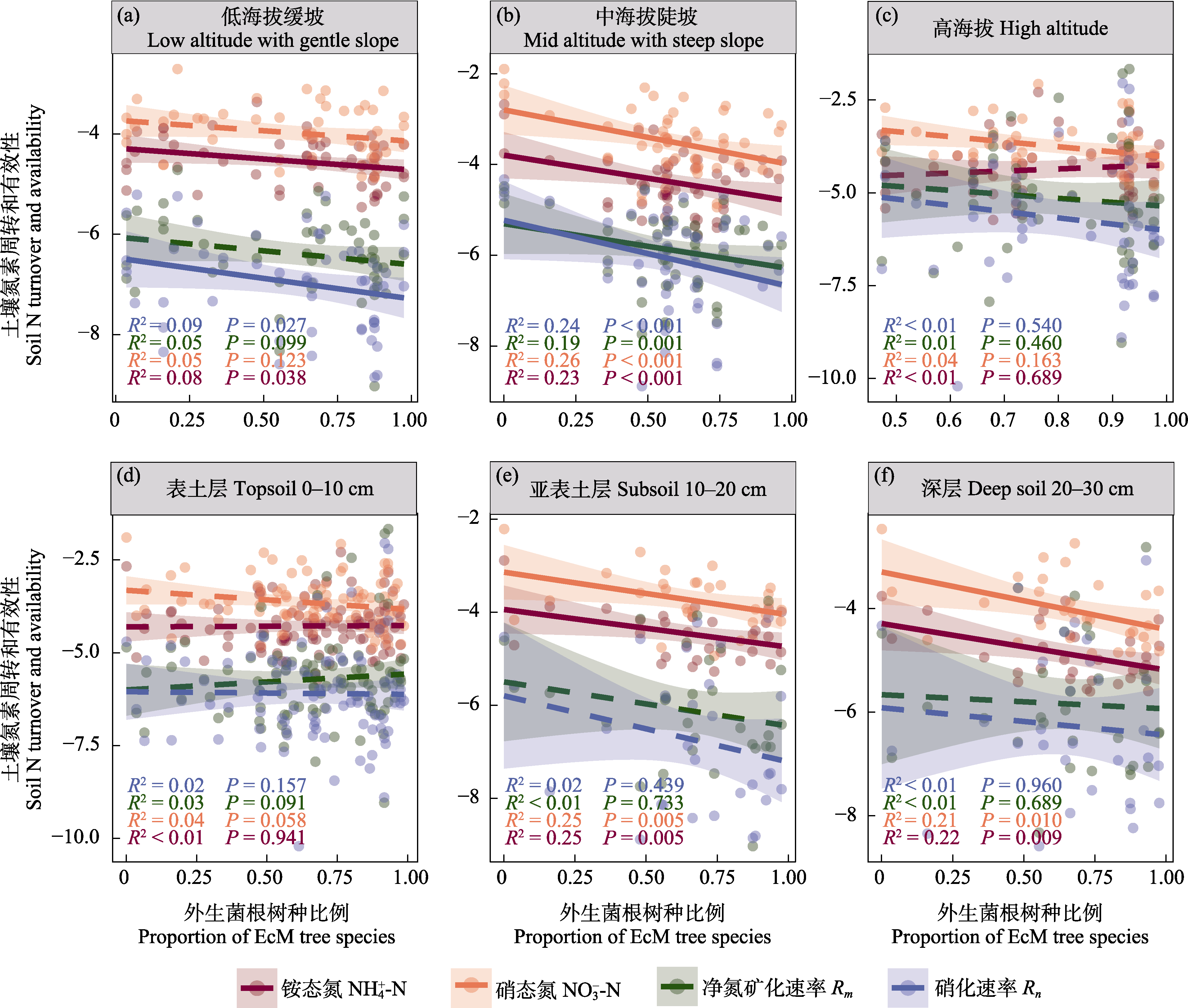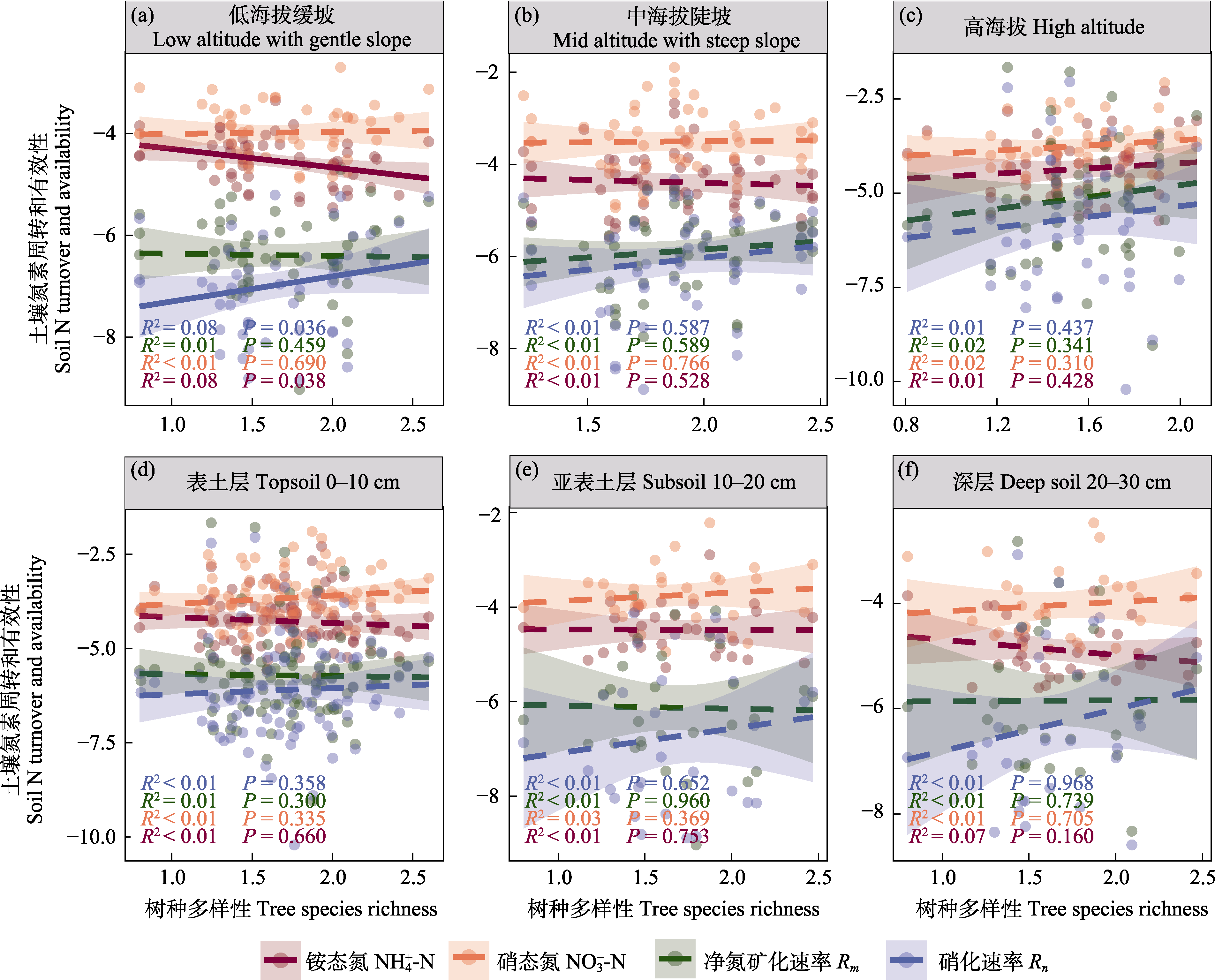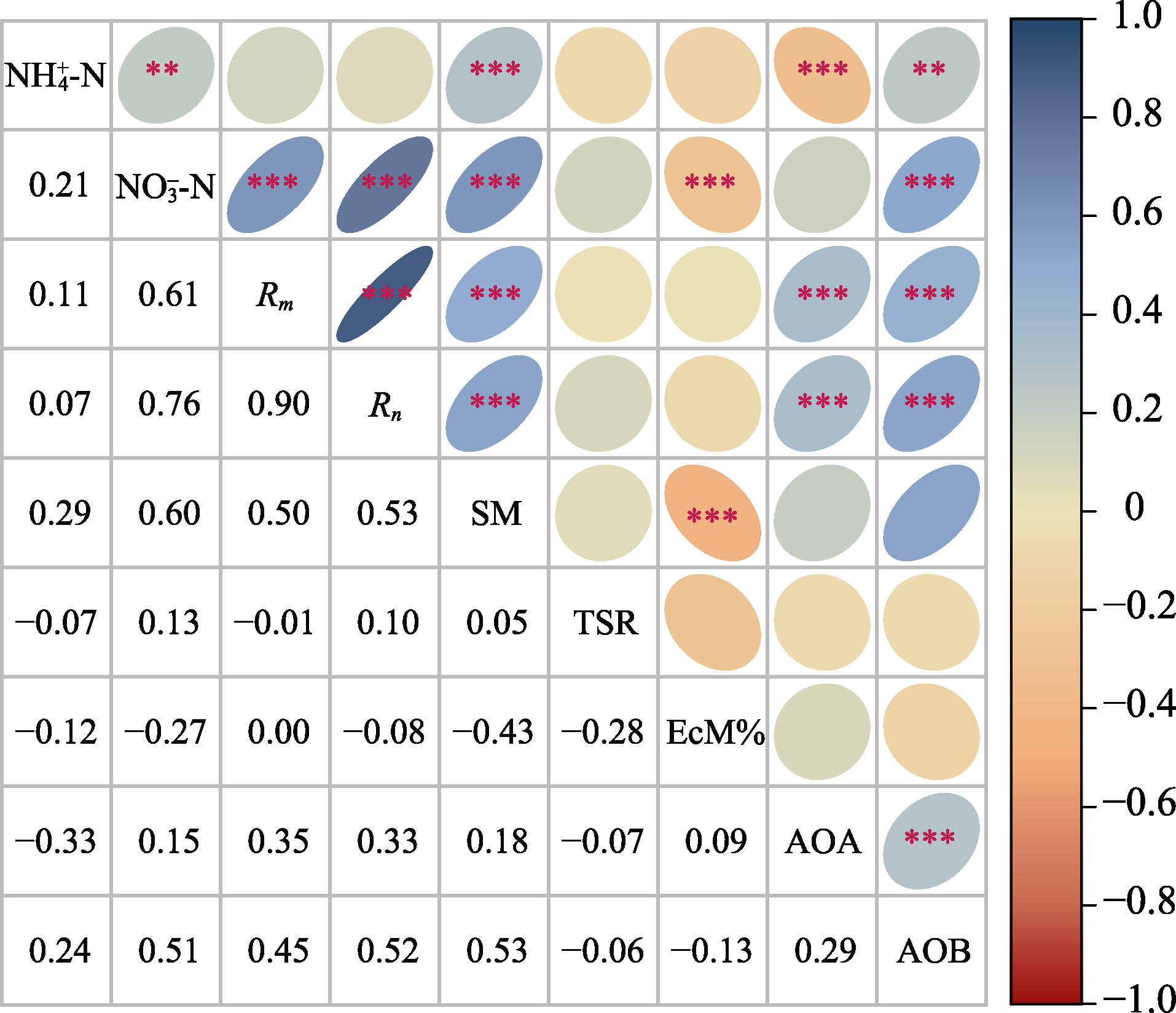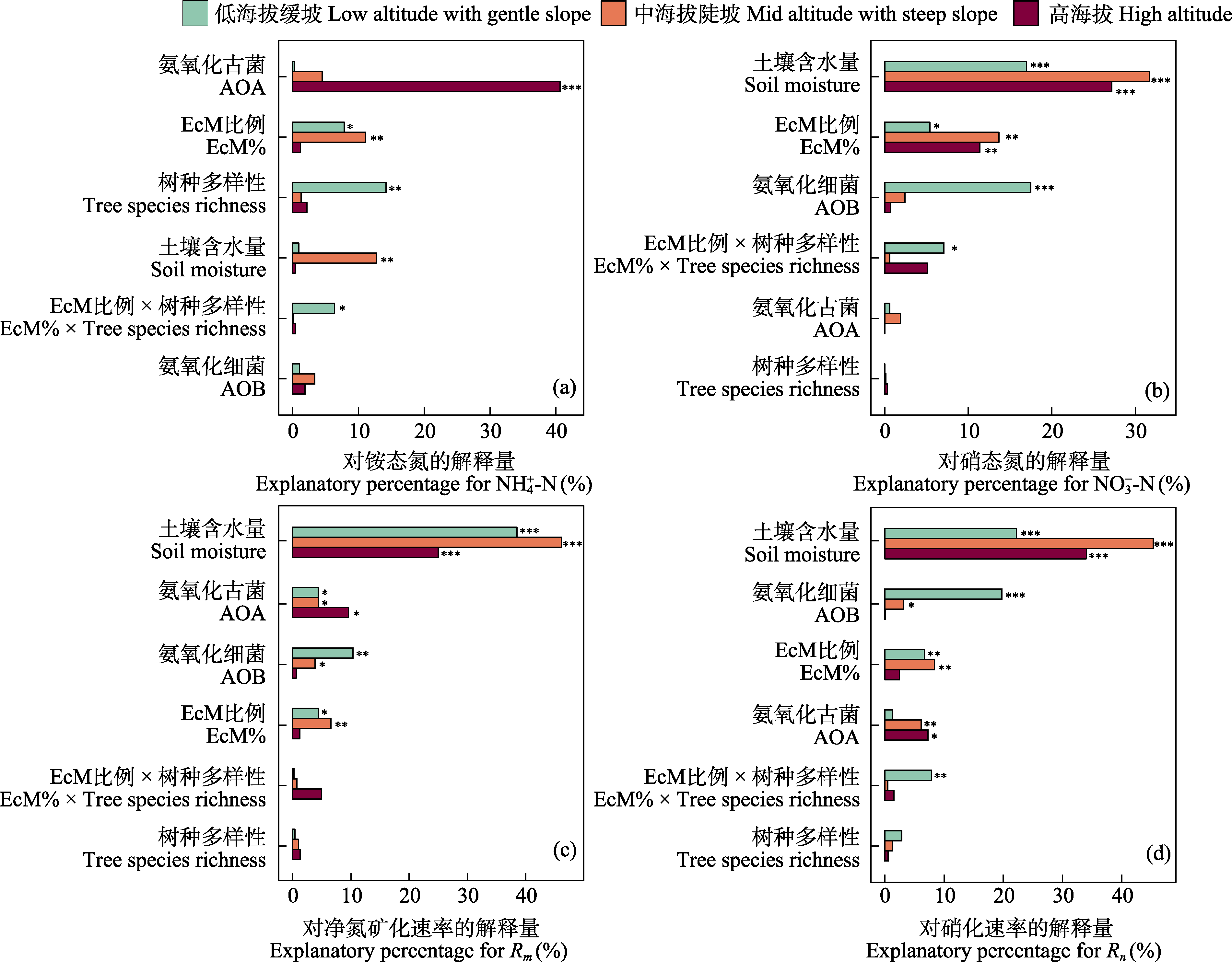



Biodiv Sci ›› 2024, Vol. 32 ›› Issue (9): 24173. DOI: 10.17520/biods.2024173 cstr: 32101.14.biods.2024173
• Ecosystem Diversity • Previous Articles Next Articles
Xinyi He1,#, Yumei Pan1,#( ), Yan Zhu4(
), Yan Zhu4( ), Jiayi Chen1, Sirong Zhang4,5(
), Jiayi Chen1, Sirong Zhang4,5( ), Naili Zhang1,2,3,*(
), Naili Zhang1,2,3,*( )(
)( )
)
Received:2024-05-08
Accepted:2024-07-17
Online:2024-09-20
Published:2024-07-23
Contact:
* E-mail: About author:#Co-first authors
Supported by:Xinyi He, Yumei Pan, Yan Zhu, Jiayi Chen, Sirong Zhang, Naili Zhang. Impact of ectomycorrhizal tree dominance and species richness on soil nitrogen turnover in a warm temperate forest[J]. Biodiv Sci, 2024, 32(9): 24173.

Fig. 1 Response of soil N turnover and availability to the proportion of ectomycorrhizal (EcM) tree species across plant communities of different habitats and soil depths. The shaded area indicates the 95% confidence interval. NH4+-N, Ammonium nitrogen content; NO3‒-N, Nitrate nitrogen content; Rm, Net nitrogen mineralization rate; Rn, Nitrification rate.

Fig. 2 Response of soil N turnover and availability to tree species richness across plant communities of different habitats and soil depths. The shaded area indicates the 95% confidence interval. NH4+-N, Ammonium nitrogen content; NO3‒-N, Nitrate nitrogen content; Rm, Net nitrogen mineralization rate; Rn, Nitrification rate.

Fig. 3 The correlation between soil N turnover and availability with vegetation community, soil physicochemical properties and microbes associated with nitrification. Red indicates a positive correlation; blue indicates a negative correlation. * P < 0.05; ** P < 0.01; *** P < 0.001. NH4+-N, Ammonium nitrogen content; NO3‒-N, Nitrate nitrogen content; Rm, Net nitrogen mineralization rate; Rn, Nitrification rate; TSR, Tree species richness; SM, Soil moisture content; EcM%, The proportion of ectomycorrhizal tree species; AOA, Ammonia-oxidizing archaea; AOB, Ammonia-oxidizing bacteria.

Fig. 4 The multiple regression analysis of soil N turnover and availability with plant communities of different habitats, soil physiochemical properties and soil microbes. Soil moisture, Soil moisture content; EcM, Ectomycorrhizal tree species; EcM%, The proportion of ectomycorrhizal tree species; AOA, Ammonia-oxidizing archaea; AOB, Ammonia-oxidizing bacteria; Rm, Net nitrogen mineralization rate; Rn, Nitrification rate. * P < 0.05; ** P < 0.01; *** P < 0.001.

Fig. 4 The multiple regression analysis of soil N turnover and availability with plant communities, soil physiochemical properties and soil microbes in different soil depth. Soil moisture, Soil moisture content; EcM, Ectomycorrhizal tree species; EcM%, The proportion of ectomycorrhizal tree species; AOA, Ammonia-oxidizing archaea; AOB, Ammonia-oxidizing bacteria. * P < 0.05; ** P < 0.01; *** P < 0.001.
| [1] |
Andersen KM, Mayor JR, Turner BL (2017) Plasticity in nitrogen uptake among plant species with contrasting nutrient acquisition strategies in a tropical forest. Ecology, 98, 1388-1398.
DOI PMID |
| [2] | Ashcroft MB, Gollan JR (2013) Moisture, thermal inertia, and the spatial distributions of near-surface soil and air temperatures: Understanding factors that promote microrefugia. Agricultural and Forest Meteorology, 176, 77-89. |
| [3] | Bhat RA, Dervash MA, Mehmood MA, Skinder BM, Rashid A, Bhat JIA, Singh DV, Lone R (2017) Mycorrhizae: A sustainable industry for plant and soil environment. In: Mycorrhiza-Nutrient Uptake, Biocontrol, Ecorestoration (eds Varma A, Prasad R, Tuteja N), pp.403-502. Springer, Cham. |
| [4] | Bobbink R, Hornung M, Roelofs JGM (2003) The effects of air-borne nitrogen pollutants on species diversity in natural and semi-natural European vegetation. Journal of Ecology, 86, 717-738. |
| [5] |
Brundrett MC, Tedersoo L (2018) Evolutionary history of mycorrhizal symbioses and global host plant diversity. New Phytologist, 220, 1108-1115.
DOI PMID |
| [6] | Brundrett MC, Tedersoo L (2020) Resolving the mycorrhizal status of important northern hemisphere trees. Plant and Soil, 454, 3-34. |
| [7] |
Brzostek ER, Dragoni D, Brown ZA, Phillips RP (2015) Mycorrhizal type determines the magnitude and direction of root-induced changes in decomposition in a temperate forest. New Phytologist, 206, 1274-1282.
DOI PMID |
| [8] |
Cardinale BJ, Matulich KL, Hooper DU, Byrnes JE, Duffy E, Gamfeldt L, Balvanera P, O’Connor MI, Gonzalez A (2011) The functional role of producer diversity in ecosystems. American Journal of Botany, 98, 572-592.
DOI PMID |
| [9] |
Cheeke TE, Phillips RP, Brzostek ER, Rosling A, Bever JD, Fransson P (2017) Dominant mycorrhizal association of trees alters carbon and nutrient cycling by selecting for microbial groups with distinct enzyme function. New Phytologist, 214, 432-442.
DOI PMID |
| [10] |
Chen L, Wang L, Lu XJ, Yin QX, Liu D (2022) Utilization of plant litter to enhance the effect of lakebank on nitrogen interception/removal from runoff: A microcosm simulation study. Environmental Engineering Science, 39, 235-247.
DOI |
| [11] | Chen SP, Wang WT, Xu WT, Wang Y, Wan HW, Chen DM, Tang ZY, Tang XL, Zhou GY, Xie ZQ, Zhou DW, Shangguan ZP, Huang JH, He JS, Wang YF, Sheng JD, Tang LS, Li XR, Dong M, Wu Y, Wang QF, Wang ZH, Wu JG, Chapin FS, Bai YF (2018) Plant diversity enhances productivity and soil carbon storage. Proceedings of the National Academy of Sciences, USA, 115, 4027-4032. |
| [12] | Chen XL, Chen HYH, Searle EB, Chen C, Reich PB (2021) Negative to positive shifts in diversity effects on soil nitrogen over time. Nature Sustainability, 4, 225-232. |
| [13] | Chen XL, Taylor AR, Reich PB, Hisano M, Chen HYH, Chang SX (2023) Tree diversity increases decadal forest soil carbon and nitrogen accrual. Nature, 618, 94-101. |
| [14] | Chen YH, Xie ZQ (2018) Effects of storage on soil biochemical properties and application of stored soil. Acta Pedologica Sinica, 55, 783-796. (in Chinese with English abstract) |
| [陈雅涵, 谢宗强 (2018) 保存过程对土壤生化指标的影响及保存土样的应用. 土壤学报, 55, 783-796.] | |
| [15] |
Corrales A, Mangan SA, Turner BL, Dalling JW (2016) An ectomycorrhizal nitrogen economy facilitates monodominance in a neotropical forest. Ecology Letters, 19, 383-392.
DOI PMID |
| [16] | De’ath G, Fabricius KE (2000) Classification and regression trees: A powerful yet simple technique for ecological data analysis. Ecology, 81, 3178-3192. |
| [17] |
Deng TT, Wei Y, Ren SY, Zhu Y (2023) Effects of topography and stand structure of warm temperate deciduous broad-leaved forest on understory herb diversity in Donglingshan, Beijing. Biodiversity Science, 31, 22671. (in Chinese with English abstract)
DOI |
|
[邓婷婷, 魏岩, 任思远, 祝燕 (2023) 北京东灵山暖温带落叶阔叶林地形和林分结构对林下草本植物物种多样性的影响. 生物多样性, 31, 22671.]
DOI |
|
| [18] |
Erguder TH, Boon N, Wittebolle L, Marzorati M, Verstraete W (2009) Environmental factors shaping the ecological niches of ammonia-oxidizing Archaea. FEMS Microbiology Reviews, 33, 855-869.
DOI PMID |
| [19] | Fornara DA, Tilman D (2008) Plant functional composition influences rates of soil carbon and nitrogen accumulation. Journal of Ecology, 96, 314-322. |
| [20] | Frelich LE, Jõgiste K, Stanturf J, Jansons A, Vodde F (2020) Are secondary forests ready for climate change? It depends on magnitude of climate change, landscape diversity and ecosystem legacies. Forests, 11, 965. |
| [21] |
Galdos MV, Brown E, Rosolem CA, Pires LF, Hallett PD, Mooney SJ (2020) Brachiaria species influence nitrate transport in soil by modifying soil structure with their root system. Scientific Reports, 10, 5072.
DOI PMID |
| [22] | Gold AC, Thompson SP, Piehler MF (2019) Nitrogen cycling processes within stormwater control measures: A review and call for research. Water Research, 149, 578-587. |
| [23] | Guiz J, Hillebrand H, Borer ET, Abbas M, Ebeling A, Weigelt A, Oelmann Y, Fornara D, Wilcke W, Temperton VM, Weisser WW (2016) Long-term effects of plant diversity and composition on plant stoichiometry. Oikos, 125, 613-621. |
| [24] | Guntiñas ME, Leirós MC, Trasar-Cepeda C, Gil-Sotres F (2012) Effects of moisture and temperature on net soil nitrogen mineralization: A laboratory study. European Journal of Soil Biology, 48, 73-80. |
| [25] | Guo P, Xing PJ, Song J, Wu LL, Li BQ, Si YJ, Li Y, Ji RQ (2022) Fungal community in roots and the root zone of Quercus mongolica and the correlations with the environmental factors. Journal of Fungal Research, 20, 173-182. (in Chinese with English abstract) |
| [郭璞, 邢鹏杰, 宋佳, 吴玲玲, 李彬琦, 司滟汲, 李玉, 冀瑞卿 (2022) 蒙古栎根系与根区土壤真菌群落组成及与环境因子的关系. 菌物研究, 20, 173-182.] | |
| [26] | Hansen K, Vesterdal L, Schmidt IK, Gundersen P, Sevel L, Bastrup-Birk A, Pedersen LB, Bille-Hansen J (2009) Litterfall and nutrient return in five tree species in a common garden experiment. Forest Ecology and Management, 257, 2133-2144. |
| [27] | Harms KE, Condit R, Hubbell SP, Foster RB (2001) Habitat associations of trees and shrubs in a 50-ha neotropical forest plot. Journal of Ecology, 89, 947-959. |
| [28] | Hobbie SE (2015) Plant species effects on nutrient cycling: Revisiting litter feedbacks. Trends in Ecology & Evolution, 30, 357-363. |
| [29] | Hou JH, Huang JH, Ma KP (2004) Eleven-year population growth dynamic of major species in a Quercus liaotungensis forest in the Dongling Mountains, Northern China. Acta Phytoecologica Sinica, 28, 609-615. (in Chinese with English abstract) |
|
[侯继华, 黄建辉, 马克平 (2004) 东灵山辽东栎林主要树种种群11年动态变化. 植物生态学报, 28, 609-615.]
DOI |
|
| [30] | Hou XK, Kou D, Hirota M, Guo T, Lang T (2023) Altitudinal variations of the rate and temperature sensitivity of soil nitrogen mineralization on the Qinghai-Tibetan Plateau. Journal of Plant Ecology, 16, rtad005. |
| [31] | Jiang XJ, Liu W, Liu Q, Jia ZJ, Wright AL, Cao ZH (2013) Soil N mineralization, nitrification and dynamic changes in abundance of ammonia-oxidizing bacteria and archaea along a 2000 year chronosequence of rice cultivation. Plant and Soil, 365, 59-68. |
| [32] | Knoepp JD, Swank WT (2002) Using soil temperature and moisture to predict forest soil nitrogen mineralization. Biology and Fertility of Soils, 36, 177-182. |
| [33] | Knops JMH, Bradley KL, Wedin DA (2002) Mechanisms of plant species impacts on ecosystem nitrogen cycling. Ecology Letters, 5, 454-466. |
| [34] | Kwak YS, Kim JH (1994) Spatial distribution of fine roots in Quercus mongolica and Quercus acutissima stands. Korean Journal of Ecology, 17, 113-119. |
| [35] | Lai JS, Mi XC, Ren HB, Ma KP (2010) Numerical classification of associations in subtropical evergreen broad-leaved forest based on multivariate regression trees—A case study of 24 hm2 Gutianshan forest plot in China. Chinese Journal of Plant Ecology, 34, 761-769. (in Chinese with English abstract) |
|
[赖江山, 米湘成, 任海保, 马克平 (2010) 基于多元回归树的常绿阔叶林群丛数量分类——以古田山24公顷森林样地为例. 植物生态学报, 34, 761-769.]
DOI |
|
| [36] |
Lama S, Velescu A, Leimer S, Weigelt A, Chen HM, Eisenhauer N, Scheu S, Oelmann Y, Wilcke W (2020) Plant diversity influenced gross nitrogen mineralization, microbial ammonium consumption and gross inorganic N immobilization in a grassland experiment. Oecologia, 193, 731-748.
DOI PMID |
| [37] | Lange M, Koller-France E, Hildebrandt A, Oelmann Y, Wilcke W, Gleixner G (2019) How plant diversity impacts the coupled water, nutrient and carbon cycles. Advances in Ecological Research, 61, 185-219. |
| [38] |
LeBauer DS, Treseder KK (2008) Nitrogen limitation of net primary productivity in terrestrial ecosystems is globally distributed. Ecology, 89, 371-379.
PMID |
| [39] | Lei HM, Chen L, Wang H, Qi XX, Liu JQ, Ouyang S, Deng XW, Lei PF, Lin GG, Kuzyakov Y, Xiang WH (2022) Dominant mycorrhizal association of trees determines soil nitrogen availability in subtropical forests. Geoderma, 427, 116135. |
| [40] | Li L, Liu HF, Bai F, Zhu Y, Li GQ, Li WC, Sang WG (2011) Species composition and community structure of four deciduous broad-leaved secondary forest in Dongling Mountain. Biodiversity Science, 19, 243-251. (in Chinese with English abstract) |
|
[李亮, 刘海丰, 白帆, 祝燕, 李广起, 李文超, 桑卫国 (2011) 东灵山4种落叶阔叶次生林的物种组成与群落结构. 生物多样性, 19, 243-251.]
DOI |
|
| [41] | Li L, Qin FC, Jiang LN, Yao XL (2020) Spatial distribution patterns of soil total nitrogen at a county scale. Acta Ecologica Sinica, 40, 1572-1579. (in Chinese with English abstract) |
| [李龙, 秦富仓, 姜丽娜, 姚雪玲 (2020) 区县域尺度土壤全氮的空间分布格局分析. 生态学报, 40, 1572-1579.] | |
| [42] | Li T, Ge LM, Zhao RT, Peng CH, Zhou XL, Li P, Liu ZL, Song HX, Tang JY, Zhang CC, Li Q, Wang M, Zou ZY (2024) Phenolic compounds weaken the impact of drought on soil enzyme activity in global wetlands. Frontiers in Microbiology, 15, 1372866. |
| [43] | Liang JJ, Crowther TW, Picard N, Wiser S, Zhou M, Alberti G, Schulze ED, McGuire AD, Bozzato F, Pretzsch H, Miguel S, Paquette A, Hérault B, Scherer-Lorenzen M, Barrett CB, Glick HB, Hengeveld GM, Nabuurs GJ, Pfautsch S, Viana H, Vibrans AC, Ammer C, Schall P, Verbyla D, Tchebakova N, Fischer M, Watson JV, Chen HYH, Lei XD, Schelhaas MJ, Lu HC, Gianelle D, Parfenova EI, Salas C, Lee E, Lee B, Kim HS, Bruelheide H, Coomes DA, Piotto D, Sunderland T, Schmid B, Gourlet-Fleury S, Sonké B, Tavani R, Zhu J, Brandl S, Vayreda J, Kitahara F, Searle EB, Neldner VJ, Ngugi MR, Baraloto C, Frizzera L, Bałazy R, Oleksyn J, Zawiła-Niedźwiecki T, Bouriaud O, Bussotti F, Finér L, Jaroszewicz B, Jucker T, Valladares F, Jagodzinski AM, Peri PL, Gonmadje C, Marthy W, O’Brien T, Martin EH, Marshall AR, Rovero F, Bitariho R, Niklaus PA, Alvarez-Loayza P, Chamuya N, Valencia R, Mortier F, Wortel V, Engone-Obiang NL, Ferreira LV, Odeke DE, Vasquez RM, Lewis SL, Reich PB (2016) Positive biodiversity-productivity relationship predominant in global forests. Science, 354, aaf8957. |
| [44] |
Liang Z, Olesen JE, Jensen JL, Elsgaard L (2019) Nutrient availability affects carbon turnover and microbial physiology differently in topsoil and subsoil under a temperate grassland. Geoderma, 336, 22-30.
DOI |
| [45] | Lin GG, Craig ME, Jo I, Wang XG, Zeng DH, Phillips RP (2022) Mycorrhizal associations of tree species influence soil nitrogen dynamics via effects on soil acid-base chemistry. Global Ecology and Biogeography, 31, 168-182. |
| [46] |
Liu HF, Li L, Sang WG (2011) Species composition and community structure of the Donglingshan forest dynamic plot in a warm temperate deciduous broad-leaved secondary forest, China. Biodiversity Science, 19, 232-242. (in Chinese with English abstract)
DOI |
|
[刘海丰, 李亮, 桑卫国 (2011) 东灵山暖温带落叶阔叶次生林动态监测样地: 物种组成与群落结构. 生物多样性, 19, 232-242.]
DOI |
|
| [47] | Liu HF, Xue DY, Sang WG (2014) Species dispersal and niche differentiation during functional development of warm temperate forests. Chinese Science Bulletin, 59, 2359-2366. (in Chinese with English abstract) |
| [刘海丰, 薛达元, 桑卫国 (2014) 暖温带森林功能发育过程中的物种扩散和生态位分化. 科学通报, 59, 2359-2366.] | |
| [48] | Liu XJ, Tan ND, Zhou GY, Zhang DQ, Zhang QM, Liu SZ, Chu GW, Liu JX (2021) Plant diversity and species turnover co-regulate soil nitrogen and phosphorus availability in Dinghushan forests, southern China. Plant and Soil, 464, 257-272. |
| [49] | Luo S, Schmid B, De Deyn GB, Yu SX (2018) Soil microbes promote complementarity effects among co-existing trees through soil nitrogen partitioning. Functional Ecology, 32, 1879-1889. |
| [50] | Luo W, Xing YJ, Wang QG (2018) Effect of nitrogen deposition on soil nitrogen budget in boreal forests: Research progress. Chinese Agricultural Science Bulletin, 34(12), 98-107. (in Chinese with English abstract) |
|
[罗维, 邢亚娟, 王庆贵 (2018) 氮沉降对北方森林土壤氮收支的影响研究进展. 中国农学通报, 34(12), 98-107.]
DOI |
|
| [51] | Ma F, Wang SZ, Feng JC, Sang WG. (2018) Spatial distribution patterns of snag and standing trees in a warm temperate deciduous broad-leaved forest in Dongling Mountain, Beijing. Acta Ecologica Sinica. 38, 5717-5725. (in Chinese with English abstract) |
| [马芳, 王顺忠, 冯金朝, 桑卫国 (2018) 北京东灵山暖温带落叶阔叶林枯立木与活立木空间分布格局. 生态学报, 38, 5717-5725.] | |
| [52] | McGrath DA, Smith CK, Gholz HL, de Assis Oliveira F (2001) Effects of land-use change on soil nutrient dynamics in Amazônia. Ecosystems, 4, 625-645. |
| [53] | Meyer ST, Ebeling A, Eisenhauer N, Hertzog L, Hillebrand H, Milcu A, Pompe S, Abbas M, Bessler H, Buchmann N, De Luca E, Engels C, Fischer M, Gleixner G, Hudewenz A, Klein AM, de Kroon H, Leimer S, Loranger H, Mommer L, Oelmann Y, Ravenek JM, Roscher C, Rottstock T, Scherber C, Scherer-Lorenzen M, Scheu S, Schmid B, Schulze ED, Staudler A, Strecker T, Temperton V, Tscharntke T, Vogel A, Voigt W, Weigelt A, Wilcke W, Weisser WW (2016) Effects of biodiversity strengthen over time as ecosystem functioning declines at low and increases at high biodiversity. Ecosphere, 7, e01619. |
| [54] | Morrison E, Lagos L, Al-Agely A, Glaab H, Johnson W, Jorquera MA, Ogram A (2017) Mycorrhizal inoculation increases genes associated with nitrification and improved nutrient retention in soil. Biology and Fertility of Soils, 53, 275-279. |
| [55] |
Phillips RP, Brzostek E, Midgley MG (2013) The mycorrhizal-associated nutrient economy: A new framework for predicting carbon-nutrient couplings in temperate forests. New Phytologist, 199, 41-51.
DOI PMID |
| [56] | Policelli N, Horton TR, Hudon AT, Patterson TR, Bhatnagar JM (2020) Back to roots: The role of ectomycorrhizal fungi in boreal and temperate forest restoration. Frontiers in Forests and Global Change, 3, 97. |
| [57] |
Prosser JI, Nicol GW (2012) Archaeal and bacterial ammonia-oxidisers in soil: The quest for niche specialisation and differentiation. Trends in Microbiology, 20, 523-531.
DOI PMID |
| [58] | Qin JH, Geng Y, Li XY, Zhang CY, Zhao XH, von Gadow K (2021) Mycorrhizal type and soil pathogenic fungi mediate tree survival and density dependence in a temperate forest. Forest Ecology and Management, 496, 119459. |
| [59] | Qin W, Zheng Y, Zhao F, Wang YL, Urakawa H, Martens-Habbena W, Liu HD, Huang XW, Zhang XX, Nakagawa T, Mende DR, Bollmann A, Wang BZ, Zhang Y, Amin SA, Nielsen JL, Mori K, Takahashi R, Armbrust EV, Winkler MK H, DeLong EF, Li M, Lee PH, Zhou JZ, Zhang CL, Zhang T, Stahl DA, Ingalls AE (2020) Alternative strategies of nutrient acquisition and energy conservation map to the biogeography of marine ammonia-oxidizing Archaea. The ISME Journal, 14, 2595-2609. |
| [60] |
Read DJ, Perez-Moreno J (2003) Mycorrhizas and nutrient cycling in ecosystems—A journey towards relevance? New Phytologist, 157, 475-492.
DOI PMID |
| [61] | Rütting T, Schleusner P, Hink L, Prosser JI (2021) The contribution of ammonia-oxidizing archaea and bacteria to gross nitrification under different substrate availability. Soil Biology and Biochemistry, 160, 108353. |
| [62] | Sardar MF, Younas F, Farooqi ZUR, Li YL (2023) Soil nitrogen dynamics in natural forest ecosystem: A review. Frontiers in Forests and Global Change, 6, 1144930. |
| [63] |
Steinweg JM, Dukes JS, Paul EA, Wallenstein MD (2013) Microbial responses to multi-factor climate change: Effects on soil enzymes. Frontiers in Microbiology, 4, 146.
DOI PMID |
| [64] |
Stempfhuber B, Engel M, Fischer D, Neskovic-Prit G, Wubet T, Schöning I, Gubry-Rangin C, Kublik S, Schloter-Hai B, Rattei T, Welzl G, Nicol GW, Schrumpf M, Buscot F, Prosser JI, Schloter M (2015) pH as a driver for ammonia-oxidizing archaea in forest soils. Microbial Ecology, 69, 879-883.
DOI PMID |
| [65] |
Wang B, Qiu YL (2006) Phylogenetic distribution and evolution of mycorrhizas in land plants. Mycorrhiza, 16, 299-363.
PMID |
| [66] | Wang YL, Lambers H (2020) Root-released organic anions in response to low phosphorus availability: Recent progress, challenges and future perspectives. Plant and Soil, 447, 135-156. |
| [67] | Xiao JY, Zhang WY, Mou YM, Lv LX (2021) Differences of drought tolerance of the main tree species in Dongling Mountain, Beijing, China as indicated by tree rings. Chinese Journal of Applied Ecology, 32, 3487-3496. (in Chinese with English abstract) |
|
[肖健宇, 张文艳, 牟玉梅, 吕利新 (2021) 树木年轮揭示的东灵山主要树种间干旱耐受性差异. 应用生态学报, 32, 3487-3496.]
DOI |
|
| [68] | Xiao RH, Duan BX, Man XL, Cai TJ, Vesala T (2023) Highly sensitive net nitrogen mineralization to soil temperature and moisture during a boreal secondary forest succession. Journal of Soils and Sediments, 23, 1169-1181. |
| [69] |
Xu SW, Su HX, Ren SY, Hou JH, Zhu Y (2023) Functional traits and habitat heterogeneity explain tree growth in a warm temperate forest. Oecologia, 203, 371-381.
DOI PMID |
| [70] | Zhang B, Chen L, Jin S, Guo QZ, Hou J (2022a) The influence of plants on the migration and transformation of nitrogen in plant-soil systems: A review. Journal of Soil Science and Plant Nutrition, 22, 4084-4102. |
| [71] | Zhang P, Lü XT, Li MH, Wu TG, Jin GZ (2022b) N limitation increases along a temperate forest succession: Evidences from leaf stoichiometry and nutrient resorption. Journal of Plant Ecology, 15, 1021-1035. |
| [72] | Zhang T, Song B, Han GX, Zhao HL, Hu QL, Zhao Y, Liu HJ (2023) Effects of coastal wetland reclamation on soil organic carbon, total nitrogen, and total phosphorus in China: A meta-analysis. Land Degradation & Development, 34, 3340-3349. |
| [73] | Zhu ZH, Du H, Gao K, Fang YT, Wang KL, Zhu TB, Zhu J, Cheng Y, Li DJ (2023) Plant species diversity enhances soil gross nitrogen transformations in a subtropical forest, Southwest China. Journal of Applied Ecology, 60, 1364-1375. |
| [1] | Yuanjie Xu, Dunmei Lin, Ming Shi, Yanjie Xie, Yizhi Wang, Zhenhua Guan, Jianying Xiang. Spatial heterogeneity and its causes in evergreen broad-leaved forests in the Ailao Mountains, Yunnan Province [J]. Biodiv Sci, 2017, 25(1): 23-33. |
| [2] | LI Yi-Ming, XU Long, MA Yong, YANG Jin-Yuan, YANG Yu-Hui. The species richness of nonvolant mammals in Shennongjia Nature Reserve, Hubei Province, China: distribution patterns along elevational gradient [J]. Biodiv Sci, 2003, 11(1): 1-9. |
| Viewed | ||||||
|
Full text |
|
|||||
|
Abstract |
|
|||||
Copyright © 2022 Biodiversity Science
Editorial Office of Biodiversity Science, 20 Nanxincun, Xiangshan, Beijing 100093, China
Tel: 010-62836137, 62836665 E-mail: biodiversity@ibcas.ac.cn ![]()